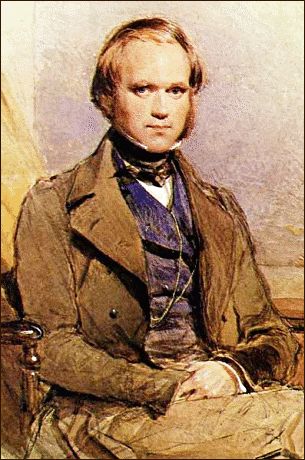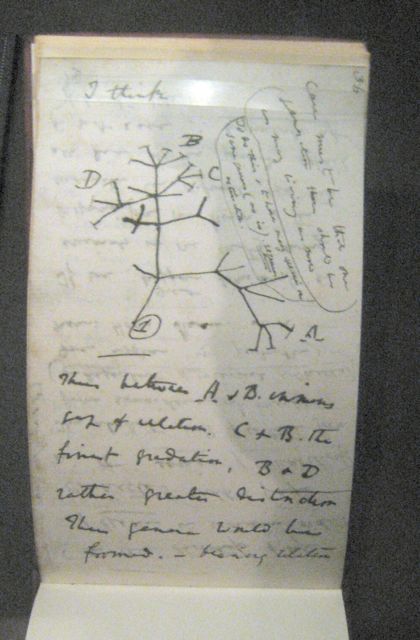I managed to make it out to the Darwin’s Big idea exhibition at the Natural History Museum last weekend. I wasn’t expecting to learn anything new about his theories, having read numerous books on the subject, but it is quite revealing of his character. When we picture Charles Darwin these days it’s in his full beard pose, looking very Victorian and distinguished, an elder scientific statesman. When he first travelled to the Galapagos Islands to begin the studies which would eventually lead to the Origin on Species, he was a young man of twenty on his gap year. Food and frolics await!
Picture the bearded figure from the standard paintings. He begins to study the Galapagos tortoises, perhaps noticing that some varieties have a saddle-like shape to their shells, whereas others on different islands don’t. Alternatively of course, he just decides that it would be good fun to sneak up on them and have a ride:
The inhabitants believe that these animals are absolutely deaf; certainly they do not overhear a person walking close behind them. I was always amused, when overtaking one of these great monsters as it was quietly pacing along, to see how suddenly, the instant I passed, it would draw in its head and legs, and uttering a deep hiss fall to the ground with a heavy sound, as if struck dead. I frequently got on their backs, and then, upon giving a few raps on the hinder part of the shell, they would rise up and walk away;—but I found it very difficult to keep my balance.
The general approach seemed to be to eat most of the potential specimens, to the extent that ‘staying out of Charles Darwin’s way’ was probably a pretty good survival strategy. Take the armadillo for instance:
we were obliged to be content with a frugal meal on an armadillo which we had shot by the way. The flesh of this animal has, indeed, an agreeable taste, resembling fowl, but is very fat
Or the puma
I was suddenly struck with horror at thinking that I was eating one of the favourite dishes of the country, namely, a half-formed calf, long before its proper time of birth. It turned out to be Puma; the meat is very white, and remarkably like veal in taste
The tortoises didn’t get away with just being ridden either:
While staying in this upper region, we lived entirely upon tortoise-meat. The breastplate roasted (as the Gauchos do carne con cuero), with the flesh attached to it, is very good; and the young tortoises make excellent soup; but otherwise the meat to my taste is very indifferent.
Oh, and just in case you’re thinking that he stuck to merely eating animals unimportant to his records, I refer you to the Lesser Rhea
When at the Rio Negro, in Northern Patagonia, I repeatedly heard the Gauchos talking of a very rare bird which they called Avestruz Petise.
He found one eventually, after eating most of it:
The bird was cooked and eaten before my memory returned. Fortunately the head, neck, legs, wings, many of the larger feathers, and a large part of the skin, had been preserved.
Preserved for his sandwiches in the morning presumably.
What isn’t mentioned is the pre-edited title of his most famous work was ‘The Origin of Species and 1001 Ways to Cook Them‘, or ‘Our tasty ancestors, an evolutionary journey into yummyness‘ .
Cooking tips aside, it’s an interesting exhibit, although the placement of the live iguana as an example of animals which didn’t live on the Galapagos, seemed a bit unnecessary. I’ll let the Horned Frog slide though (I like frogs).
It covers the famous voyage of the Beagle, examples from his notebooks, including the first sketch of the familiar tree structure of animal classification. It then shows a reproduction of his study, complete with wheeled chair to save getting up and various animal skeletons to show similarities in bone structure and development. It finishes with a brief look at some of the controversies which surrounded his theory which, ironically, seems to be more challenged these days than it was at the time!
Give it a look, but remember to take some lunch with you, you might come out feeling peckish and I think they’d object if you tried to eat the iguana.




Dear Grumpy BobIt was good to more publicity for Royal Mail’s new stamp issue on Darwin. However, there are two tnhgis wrong with this. Firstly the images are copyright Royal Mail and this should be acknowledged by anybody who has obtained permission to use them.Secondly we prefer that people do not hotlink to images hosted on our server. The correct netiquette is to host the images on your own server or other free space and there is plenty of free space on photobucket, flickr, picassa etc and then link to there. As it is you are linking to our server and anybody who looks at your blog accesses the pictures that we host.Please correct thisMany thanksIan